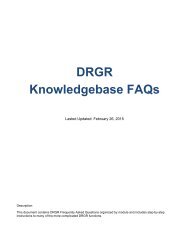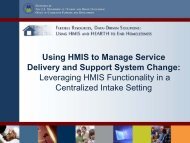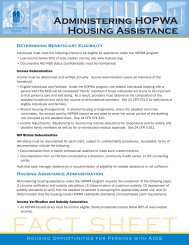HMIS Project Management Topics and Tools - OneCPD
HMIS Project Management Topics and Tools - OneCPD
HMIS Project Management Topics and Tools - OneCPD
- No tags were found...
Create successful ePaper yourself
Turn your PDF publications into a flip-book with our unique Google optimized e-Paper software.
<strong>HMIS</strong> <strong>Project</strong> <strong>Management</strong> <strong>Topics</strong> <strong>and</strong> <strong>Tools</strong>of their responsibilities for keeping client information safe <strong>and</strong> confidential at the agencylevel as outlined in the Final Notice. A special security training can be provided to keyagency staff or to all staff to ensure that they underst<strong>and</strong> <strong>and</strong> adopt appropriate securityprotocols. Some communities have also incorporated broader ethics training touching onissues of confidentiality, disclosure, <strong>and</strong> grievance procedures.For each of the training types listed above, trainers <strong>and</strong> project managers should work together todevelop a st<strong>and</strong>ard curriculum <strong>and</strong> review <strong>and</strong> revise it periodically. They will also need todevelop training materials to h<strong>and</strong> out to participants. These materials should also be updated asneeded. The project manger should try to gauge the effectiveness of the training by creating atraining evaluation form with numeric scales. Appendix 5 contains an Evaluation Form used inMassachusetts for its basic user training. Other communities actually administer a test before<strong>and</strong> after the training to measure how much the trainees learned. Those who fail the test do notreceive passwords. The tests serve the dual purpose of evaluating the effectiveness of thetraining <strong>and</strong> ensuring that everyone accessing the system underst<strong>and</strong>s the key concepts.Each training session should also contain an inspirational segment for end users. This willremind end users that they have a stake in the project <strong>and</strong> will help with the long-term goal ofcollecting quality data. Trainers may want to begin each training by outlining some of thebenefits of data collection or by asking end users who have been entering data to talk aboutbenefits for them, their agencies <strong>and</strong>/or consumers.Data AnalystData analysts are sometimes part of the <strong>HMIS</strong> project team, especially in later stages. Effectivedata mining <strong>and</strong> data analysis can benefit the community by providing a competitive edge ingrant applications, as well as advancing the overall <strong>HMIS</strong> goals of improving service planning,educating the community, <strong>and</strong> influencing policy.A data analyst may help clean project data by eliminating or merging potential duplicate records.The analyst may also determine how data fields <strong>and</strong> categories should be combined, for example,whether income from selling a street newspaper should count as employment income. He or shemay also help determine whether particular data should be considered as “outliers” <strong>and</strong> thereforenot included in aggregate data. For example, a homeless client earning $3,000 a month may ormay not be considered valid. Ultimately, the analyst aggregates the data in order to present totalcounts <strong>and</strong> percentages in various categories, <strong>and</strong> helps determine which data is most critical forpolicy or research purposes.If the community has less than 100% coverage, the analyst can use extrapolation methodologiesto determine whether the results are skewed by data entry shortcomings or whether the data arestatistically valid. He or she can also help determine whether apparent trends <strong>and</strong> variationsbetween sub-groups are statistically significant. For example, if the percentage of homelesswomen entered in the <strong>HMIS</strong> was smaller in one year than the next, this may represent an actualtrend or just a statistical “blip” within a margin of error. Analysts can also help interpret the datawithin the larger community <strong>and</strong> policy context, by comparing findings to similar studies inother communities or relating the results to changes in particular policies.15
















